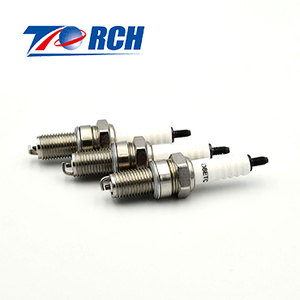
All categories
Featured selections
Trade Assurance
Buyer Central
Help Center
Get the app
Become a supplier

(3301 products available)













































A car engine candle, also known as a spark plug, is an electrical component that is intended to ignite the air-fuel mixture in the combustion chamber of an engine. There are different types of spark plugs, including:
Manufacturers often indicate specifications of car engine candles to help users choose the right fit for their vehicles. Here are some of the specifications to watch out for:
Type of Car Engine Candle
As discussed earlier, there are several types of car engine candles. One is likely to be specified for a given vehicle depending on the make and model. However, it's worth noting that iridium and platinum engine candles last longer and are more expensive than the others.
Thread Size
This is the diameter of the car engine candle in millimeters and the thread pitch in inches. For example, a car engine candle may be described as 14mm/1.25. 14mm indicates the thread size, while 1.25 inches is the thread pitch.
Reach Length
Reach length is the distance from the tip of a car engine candle to its mounting flange. It is measured in inches or millimeters. A long reach engine candle may cause engine failure, while a short one won't provide a proper fit.
Heat Range
Heat range is a specification that differentiates one car engine candle from another. It is the ability of the candle to resist heat and maintain a consistent firing temperature. The heat range is divided into cold, medium, and hot. A car engine candle with a hot heat range is ideal for high-speed or heavy-load vehicles.
Gap Size
Gap size is the distance between the two electrodes of a car engine candle. It is measured in inches or millimeters. A gap size that is too big or too small can affect engine performance. Generally, a gap size of 0.7 to 1.1mm is ideal for most vehicles.
Voltage Requirements
Different engine candles have varying voltage requirements. The requirements are specified in volts. A candle with higher voltage requirements produces a more powerful spark and is ideal for high-performance vehicles.
Follow the steps below to maintain car engine candles:
When buying candles for wholesale, here are some of the factors to consider:
Brand reputation
Car owners will be loyal to reputable brands. Therefore, as a retailer, stock up on candles from trusted and well-known brands. Read online reviews and customer feedback to help determine a brand's reputation.
Compatibility
Ensure the candles sourced from suppliers are compatible with various car makes and models. Avoid sourcing a limited candle that only fits a few cars. Ideally, the goal is to sell as many candles as possible. Therefore, stock up on a wide variety of sizes, types, and designs to cater to diverse clientele needs.
Quality and durability
As mentioned earlier, candles are not a one-time purchase. Therefore, as a retailer, it is important to evaluate the quality and durability of the candles before purchasing. Source from suppliers that offer high-quality and long-lasting products.
Cost
Consider the cost of the candles before purchasing. While they should be affordable, avoid overly cheap products as they may not be of good quality. Remember to consider other costs such as shipping, taxes, and customs duties.
Market trends
Stay ahead of the market trends. For example, currently, there is a growing consumer preference for eco-friendly products. Therefore, if there's a demand for candles made from sustainable materials like bamboo, stock up on the product.
Safety and compliance
Ensure the candles sourced from suppliers meet all the industry standards and regulations. The candles should also have all the necessary certifications to prove they are safe and compliant.
Supplier reputation
Source from a reputable supplier with positive reviews. Additionally, consider the reliability of the supplier in terms of timely delivery and customer support.
Replacing an engine candle is a simple process that can be done at home with basic tools. Before getting into the step-by-step guide on how to DIY and replace a car engine candle, here are the tools and materials needed:
Steps to Replace Car Engine Candle
Q1: How often should engine candles be replaced?
A1: Generally, car owners should replace engine candles every 30,000 to 100,000 miles. However, the exact interval can differ based on the type of spark plug used and the recommendations of the vehicle's manufacturer.
Q2: Can a car run without a spark plug?
A2: No, a vehicle cannot operate without a spark plug, more particularly without a gasoline engine. The spark plug is essential for igniting the air-fuel mixture in the engine's combustion chamber. Without it, the engine cannot start or run.
Q3: What is the distinction between engine candles and spark plugs?
A3:There is no difference between engine candles and spark plugs. "Engine candle" is just a colloquial term used in some areas to refer to spark plugs.
Q4: What indications suggest a need for a replacement engine candle?
A4: Typical signs of wear or damage to an engine candle include difficulty starting the car, engine misfires, poor acceleration, decreased fuel efficiency, and a rough idle. Visibly worn or dirty spark plugs can also be signs that require replacement.
Q5: Can DIY replace engine candles?
A5: Yes, replacing engine candles is a task that many DIYers can handle. With basic mechanical knowledge, the right tools, and a guide or tutorial, one can replace the engine candles themselves. Nonetheless, to ensure proper and safe installation, it is advisable to follow the manufacturer's instructions and, if necessary, consult an expert.